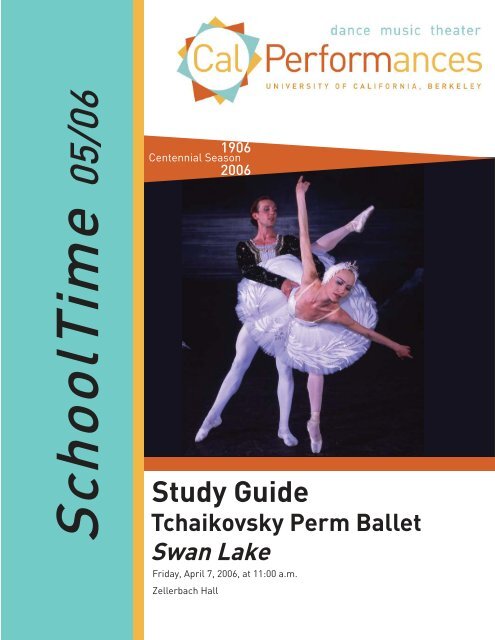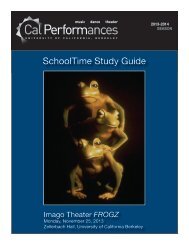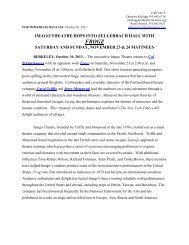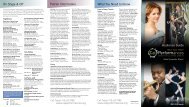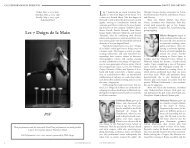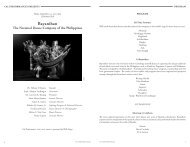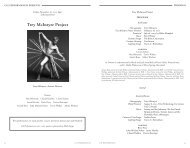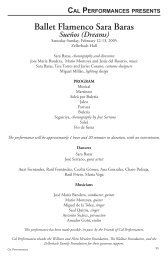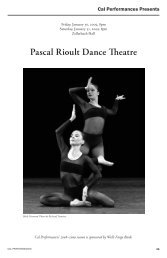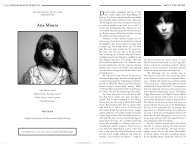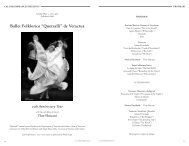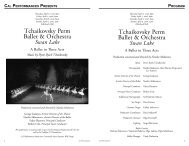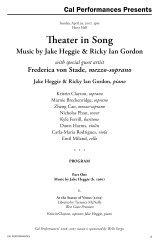Tchaikovsky Perm Ballet Swan Lake - Cal Performances - University ...
Tchaikovsky Perm Ballet Swan Lake - Cal Performances - University ...
Tchaikovsky Perm Ballet Swan Lake - Cal Performances - University ...
Create successful ePaper yourself
Turn your PDF publications into a flip-book with our unique Google optimized e-Paper software.
SchoolTime 05/06<br />
1906<br />
Centennial Season<br />
2006<br />
Study Guide<br />
<strong>Tchaikovsky</strong> <strong>Perm</strong> <strong>Ballet</strong><br />
<strong>Swan</strong> <strong>Lake</strong><br />
Friday, April 7, 2006, at 11:00 a.m.<br />
Zellerbach Hall
Welcome<br />
March 28, 2006<br />
Dear Educator and Students,<br />
Welcome to SchoolTime! On Friday, April 7, 2006, at 11:00 a.m., <strong>Cal</strong> <strong>Performances</strong><br />
presents the SchoolTime performance of <strong>Swan</strong> <strong>Lake</strong> by the Tchiakovsky <strong>Perm</strong> <strong>Ballet</strong> &<br />
Orchestra at Zellerbach Hall on the UC Berkeley campus.<br />
The <strong>Tchaikovsky</strong> <strong>Perm</strong> <strong>Ballet</strong> & Orchestra is one of Russia’s most distinguished<br />
companies. Presenting classical and contemporary orchestra, ballet and opera<br />
compositions, the company places an emphasis on the ballets and operas of Pyotr<br />
<strong>Tchaikovsky</strong>, who was born near <strong>Perm</strong>.<br />
This study guide will prepare your students for their fi eld trip to Zellerbach Hall. Your<br />
students can actively participate at the performance by:<br />
• OBSERVING how the dancers use their bodies<br />
• LISTENING to the musical score by Pyotr Illyich <strong>Tchaikovsky</strong><br />
• THINKING ABOUT how mine is used in ballet to express the story<br />
• REFLECTING on their experience in the theater<br />
We look forward to seeing you at Zellerbach Hall!<br />
Sincerely,<br />
Laura Abrams Rachel Davidman<br />
Director Education Programs Administrator<br />
Education & Community Programs
About <strong>Cal</strong> <strong>Performances</strong><br />
and SchoolTime<br />
The mission of <strong>Cal</strong> <strong>Performances</strong> is to inspire, nurture and sustain a lifelong appreciation<br />
for the performing arts. <strong>Cal</strong> <strong>Performances</strong>, the performing arts presenter of the <strong>University</strong><br />
of <strong>Cal</strong>ifornia, Berkeley, fulfi lls this mission by presenting, producing and commissioning<br />
outstanding artists, both renowned and emerging, to serve the <strong>University</strong> and the broader<br />
public through performances and education and community programs. In 2005/06 <strong>Cal</strong><br />
<strong>Performances</strong> celebrates 100 years on the UC Berkeley Campus.<br />
Our SchoolTime program cultivates an early appreciation for and understanding of the<br />
performing arts amongst our youngest audiences, with hour-long, daytime performances by<br />
the same world-class artists who perform as part of the main season. Teachers have come to<br />
rely on SchoolTime as an integral and important part of the academic year.<br />
Sponsors of <strong>Cal</strong> <strong>Performances</strong> Education and Community Programs<br />
<strong>Cal</strong> <strong>Performances</strong>’ Education and Community Programs are supported by <strong>Cal</strong>ifornia Arts Council, Walter &<br />
Elise Haas Fund, National Endowment for the Arts, The Wallace Foundation, The Zellerbach Family. Additional<br />
support is provided by Berkeley Community Fund, <strong>Cal</strong>ifornia Savings Bank, Citibank, East Bay Community<br />
Foundation, Robert J. and Helen H. Glaser Family Foundation, McKesson Foundation, The San Francisco<br />
Foundation and Union Bank of <strong>Cal</strong>ifornia.
SchoolTime Study Guide<br />
<strong>Tchaikovsky</strong> <strong>Perm</strong> <strong>Ballet</strong><br />
<strong>Swan</strong> <strong>Lake</strong><br />
Friday, April 7, 2006, at 11:00 am<br />
Zellerbach Hall<br />
Table of Contents<br />
1. Theater Etiquette ..............................................................................1<br />
2. Setting the Stage ...............................................................................2<br />
3. About the SchoolTime Performance: <strong>Swan</strong> <strong>Lake</strong> .................................3<br />
4. About the Artists ...............................................................................5<br />
5. About the Art Form: <strong>Ballet</strong> ................................................................7<br />
6. Learning Activities ..........................................................................10<br />
7. Connections to <strong>Cal</strong>ifornia State Standards .....................................12
1 Theater Etiquette<br />
Be prepared and arrive early Ideally you should arrive at the theater 30 to 45<br />
minutes before the show. Allow for travel time and parking, and be in your seats at least 15<br />
minutes before the performance begins.<br />
Be aware and remain quiet The theater is a “live” space—you can hear<br />
the performers easily, but they can also hear you, and you can hear other audience<br />
members, too! Even the smallest sounds, like rustling papers and whispering can be<br />
heard throughout the theater—so it’s best to stay quiet so that everyone can enjoy the<br />
performance without distractions. The international sign for “Quiet Please” is to silently<br />
raise your index fi nger to your lips.<br />
Show appreciation by applauding Applause is the best way to show your<br />
enthusiasm and appreciation. Performers return their appreciation for your attention by<br />
bowing to the audience at the end of the show. It is always appropriate to applaud at the end<br />
of a performance, and it is customary to continue clapping until the curtain comes down or<br />
the house lights come up.<br />
Participate by responding to the action onstage Sometimes during a<br />
performance, you may respond by laughing, crying or sighing. By all means, feel free to do<br />
so! Appreciation can be shown in many different ways, depending upon the art form. For<br />
instance, an audience attending a string quartet performance will sit very quietly, while the<br />
audience at a gospel concert may be inspired to participate by clapping and shouting.<br />
Concentrate to help the performers Performers use concentration to focus<br />
their energy while on stage. If the audience is focused while watching the performance, the<br />
artists feel supported and are able to do their best work. They can feel that you are with them!<br />
1
2 Setting the Stage<br />
Learning Objectives<br />
• Students will become familiar with the classic story of <strong>Swan</strong> <strong>Lake</strong><br />
• Students will be able to recognize characteristics of classical ballet<br />
• Students will become familiar ballet vocabulary<br />
Pre-Performance Activities<br />
Choosing at least one of these pre-performance activities will give your students a<br />
framework for their fi eld trip experience and will allow them to better understand what they<br />
see on stage.<br />
• Listen to <strong>Tchaikovsky</strong>’s music for <strong>Swan</strong> <strong>Lake</strong>. Identify the recurring musical theme<br />
and then listen for it during the performance.<br />
• Read the story of <strong>Swan</strong> <strong>Lake</strong> and discuss characteristics of fairytales.<br />
• Try a few of the basic ballet positions with your feet.<br />
Questions to Think About During the Performance<br />
Reviewing these questions with your students prior to the performance will prepare them<br />
for their experience in the theater. Students who are familiar with the vocabulary, concepts<br />
and themes they will encounter in the show are much more likely to enjoy and understand the<br />
performance.<br />
• What do you notice about the way the dancers move? What are some<br />
characteristics of classical ballet?<br />
• What pantomime gestures did you notice? What were the characters<br />
expressing?<br />
• How would you describe what you saw to a friend?<br />
2
3 About the SchoolTime Performance<br />
<strong>Swan</strong> <strong>Lake</strong><br />
Written by Trudy Garfunkel<br />
<strong>Swan</strong> <strong>Lake</strong>, a classical<br />
ballet of romance and<br />
tragedy, is one of the crown<br />
jewels of 19th century ballet.<br />
Its melodic score by Peter<br />
Ilyich <strong>Tchaikovsky</strong> is fi lled<br />
with beauty and grandeur.<br />
The <strong>Tchaikovsky</strong> <strong>Perm</strong> <strong>Ballet</strong> & Orchestra, one of Russia’s premier companies, brings a<br />
traditional version of Act II of this moving, psychological dance drama alive in an elaborate<br />
production featuring 125 dancers and musicians.<br />
Brief History of <strong>Swan</strong> <strong>Lake</strong><br />
<strong>Swan</strong> <strong>Lake</strong>, a ballet with music by Pyotr Ilyich <strong>Tchaikovsky</strong> (1840-1893), is based<br />
on a Russian fairy tale about an evil sorcerer who turns young girls into birds. The fi rst<br />
production in Moscow in 1877 was a failure. The staging was considered dull and routine<br />
and <strong>Tchaikovsky</strong>’s music was not appreciated by the public. The prima ballerina thought it<br />
too diffi cult to dance, so she felt free to insert her favorite music into the score and dance<br />
her favorite choreography from other ballets. The ballet was not performed again for many<br />
years. However, by the time <strong>Tchaikovsky</strong> died in 1893<br />
his genius had been recognized worldwide. Fifteen<br />
months after his death, a new production of the<br />
ballet was presented at St. Petersburg’s Mariinsky<br />
Theater as a tribute. Marius Petipa (1822-1910)<br />
choreographed the fi rst and third acts; Lev Ivanov<br />
(1834-1901) choreographed the second and fourth<br />
acts.<br />
The production of <strong>Swan</strong> <strong>Lake</strong> performed by the<br />
<strong>Tchaikovsky</strong> <strong>Perm</strong> <strong>Ballet</strong> is based on the version by<br />
Petipa and Ivanov with additional material by Russian<br />
dancer, choreographer, and teacher Aleksandr Gorsky<br />
(1871-1924). Gorsky added elements to intensify the<br />
drama and clarify the psychological motivation of the<br />
characters. The company’s current production has<br />
been staged by internationally renowned ballerina,<br />
Natalia Makarova.<br />
3
Synopsis of <strong>Swan</strong> <strong>Lake</strong><br />
Act II will be presented at the SchoolTime performance<br />
ACT I (The Palace Garden): At Prince Siegfried’s 21st birthday celebration, his mother<br />
reminds him that it is time to choose a bride. As the festivities end, a fl ock of swans is seen<br />
in the distance; the Prince and his friends decide to hunt them. This act contains examples<br />
of solos, pas de trois (dances for three people) and dances for the ensemble.<br />
ACT II (The <strong>Lake</strong>side): Siegfried meets Odette, the <strong>Swan</strong> Queen. Odette is really a princess<br />
who is under the spell of the evil wizard, Von Rothbart. Odette and her handmaidens have<br />
been turned into swans and can assume human form only between midnight and dawn. For<br />
the spell to be broken, a man must swear his eternal love to Odette. Prince Siegfried does<br />
so, promising to be faithful to Odette forever. The highlight of this act is the pas de deux<br />
(dance for two people) for the <strong>Swan</strong> Queen and the Prince in which they demonstrate their<br />
growing love for each other.<br />
ACT III (The Palace Ballroom): Siegfried’s mother the Queen has invited princesses from<br />
many lands to meet the Prince. Von Rothbart tricks Siegfried into proposing marriage to the<br />
wizard’s daughter, the Black <strong>Swan</strong>, Odile, thereby causing the Prince to break his promise to<br />
Odette. When the Prince realizes his terrible mistake, he rushes from the palace in despair.<br />
This act is fi lled with a number of ethnically fl avored dances refl ecting the cultures of the<br />
visiting princesses<br />
ACT IV (The <strong>Lake</strong>side): All versions of <strong>Swan</strong> <strong>Lake</strong> do not end the same way . Sometimes one<br />
of the lovers dies, some times they live happily ever after. In this version, by the <strong>Tchaikovsky</strong><br />
<strong>Perm</strong> <strong>Ballet</strong>, both Odette and Siegfried die at the end.<br />
Main Characters<br />
Von Rothbart-the evil wizard<br />
Siegfried- the prince<br />
The Queen-Siegfried’s mother<br />
Benno-Siegfried’s friend<br />
Odette-the beautiful enchanted<br />
swan<br />
Odile-Odette’s wicked double<br />
Odile and Siegfried in Scene II<br />
4
4 About the Artists:<br />
<strong>Tchaikovsky</strong> <strong>Perm</strong> <strong>Ballet</strong> & Orchestra<br />
The <strong>Tchaikovsky</strong> <strong>Perm</strong> <strong>Ballet</strong> & Orchestra<br />
The <strong>Tchaikovsky</strong> <strong>Perm</strong> <strong>Ballet</strong> & Orchestra is one of two groups<br />
under the umbrella of The <strong>Tchaikovsky</strong> Opera and <strong>Ballet</strong> Theater.<br />
The <strong>Tchaikovsky</strong> Opera and Orchestra (sometimes referred to as<br />
the <strong>Perm</strong> <strong>Tchaikovsky</strong> Opera and Orchestra) is the other group.<br />
The <strong>Tchaikovsky</strong> Opera and <strong>Ballet</strong> Theater is based in <strong>Perm</strong>,<br />
a port city in the Russian Urals. <strong>Perm</strong>, which has more than 1.2<br />
million inhabitants, is located 1,000 miles from the capital city of<br />
St. Petersburg. The opera company of The <strong>Tchaikovsky</strong> Opera &<br />
<strong>Ballet</strong> Theater was founded 1870, and the ballet company became<br />
a permanent institution in the mid-1920s. Known for its exemplary<br />
productions of the operas and ballets by Peter Ilyich <strong>Tchaikovsky</strong>,<br />
the <strong>Tchaikovsky</strong> Opera and <strong>Ballet</strong> Theater has also produced and<br />
performed a growing number of other classical and contemporary<br />
works. The <strong>Tchaikovsky</strong> <strong>Perm</strong> <strong>Ballet</strong> Orchestra, a company of 125<br />
dancers, soloists, and musicians, is one of Russia’s most distinguished arts organizations. It<br />
is unique in that it draws all of its dancers from its own school, the most prestigious training<br />
institution for ballet in all of Russia.<br />
Natalia Makarova<br />
The <strong>Tchaikovsky</strong> Opera & <strong>Ballet</strong><br />
Theater in <strong>Perm</strong>, Russia<br />
Born in 1940, Natalia Makarova entered the famed Vaganova <strong>Ballet</strong> Academy in her<br />
native Leningrad at age 13, and was placed in an experimental program that condensed<br />
the nine-year program into six years. She joined the Kirov <strong>Ballet</strong>, following graduation and<br />
quickly rose to the rank of ballerina. Her international fame<br />
grew from her performance of Giselle with the Kirov <strong>Ballet</strong> in<br />
London. She became known for both outstanding classical<br />
technique and the ability to emotionally embody the characters<br />
she danced. Giselle became one of her signature roles. In<br />
1970, she joined the American <strong>Ballet</strong> Theatre, dancing its vast<br />
repertory and working with Anthony Tudor, George Balanchine,<br />
Jerome Robbins and Glen Tetley. In 1972, she began an<br />
association with the Royal <strong>Ballet</strong> in London, and appeared as<br />
a guest artist with major ballet companies worldwide in her<br />
dance career. In 1980, Makarova staged the fi rst full-length<br />
production of La Bayadere in the West for American <strong>Ballet</strong><br />
Theatre, a production that is now in the repertoire of companies<br />
worldwide.<br />
5
In 1989, Natalia Makarova was the fi rst Russian artist-in-exile invited to perform in the<br />
Soviet Union. She returned to her native Leningrad and danced with the Kirov <strong>Ballet</strong> on the<br />
stage where she began her career. Makarova Returns, a documentary fi lm of this historic<br />
event, was produced by the BBC. While Makarova’s <strong>Swan</strong> <strong>Lake</strong> contains some of the classic<br />
choreography by Petipa and Ivanov, she also acknowledges the contribution of Sir Frederick<br />
Ashton to the production.<br />
Russian-born composer Pyotr Ilyich <strong>Tchaikovsky</strong> (1840-1893) did more than any other<br />
composer to elevate the quality of ballet music in the 19th century, making it an equal<br />
partner of the choreography. His ballet scores are symphonic and fi lled with rich melodies;<br />
they are evocative and speak directly to the listener’s emotions.<br />
His scores are not just unrelated tunes strung together; his<br />
music helps tell the story. In addition to three ballet scores,<br />
<strong>Tchaikovsky</strong> produced nine operas, six symphonies, three string<br />
quartets, numerous chamber works and concertos for various<br />
instruments, overtures, short pieces for piano and over 100<br />
songs and choral works.<br />
The choreographer Marius Petipa (1822-1910) is responsible in<br />
large part for revitalizing ballet as an art form. A ballet master<br />
and choreographer from France, Petipa arrived in Russia in 1847.<br />
During his 60-year career at the Mariinsky Theater’s Imperial<br />
<strong>Ballet</strong>, he created 46 new ballets and revised 17 more.<br />
Petipa’s genius was for combining the basic steps and<br />
movements of classical ballet into endlessly innovative<br />
patterns and inventive variations. His ballets were lavish, multiact<br />
spectacles with romantic or storybook plots. They were fi lled<br />
with regal processions, folk and national dances, mime and<br />
divertissements (suites of dances that have nothing to do with the<br />
plot but are meant purely to entertain or show off the talents of the<br />
dancers), as well as numerous solos, duets, trios and ensembles<br />
for waves of dancers who crisscrossed the stage in intricate<br />
designs.<br />
Pyotr Ilyitch <strong>Tchaikovsky</strong><br />
(1840–1893)<br />
Marius Petipa (1822–1910)<br />
Interesting Note:<br />
Russian classical ballet reached its height in three ballets created in the last decade of the<br />
19th century. All had musical scores by Peter Ilyich <strong>Tchaikovsky</strong>. These ballets, which are<br />
all still danced today in many different versions, are The Sleeping Beauty (1890,<br />
choreographed by Marius Petipa), The Nutcracker (1892, choreographed by Lev Ivanov) and<br />
<strong>Swan</strong> <strong>Lake</strong> (1895, choreographed by Ivanov and Petipa).<br />
6
5 About the Art Form: <strong>Ballet</strong><br />
Classical ballet is a form of dance that originated in the royal courts of France in the<br />
1500s. The fi rst known ballet, the Balet comique de la Royne was performed in Paris in<br />
1581. <strong>Ballet</strong> is characterized by graceful yet precise articulation of the body. Dancers hold<br />
their bodies in an upright position and the legs are turned out from the hips. In general the<br />
body is lifted, the arms and legs extend out away from the body and many of the turns and<br />
movements are done high on the balls of the feet or even on pointe. <strong>Ballet</strong> uses fi ve basic<br />
positions of the feet, and the terminology you would hear in a ballet class is in French.<br />
Mime in <strong>Ballet</strong><br />
Pantomime or Mime—acting without words or speech translated into movement—is one<br />
of the oldest forms of theater and is found in traditions around the world. The pantomime<br />
tradition in ballet, which goes back to Renaissance court entertainments, was also<br />
infl uenced by the commedia dell’arte, a form of traveling street theater that arose in<br />
Italy in the mid-16th century and became popular all over Europe. Commedia dell’arte<br />
used improvised dialogue, masked stock characters, dancing, acrobatics, and mime to<br />
present plays based on a limited set of easily identifi ed scenarios. The younger roles (e.g.,<br />
Harlequin, Pierrot, Pierette, Pulcinella and Columbine) were taken by the best dancers.<br />
Specifi c dramatic gestures conveying meaning, feeling and actions are an important feature<br />
of classical story ballets such as <strong>Swan</strong> <strong>Lake</strong>. There are dozens of “words” in the language of<br />
ballet mime.<br />
7
Excercise: Introduction to Mime<br />
anger - shake your fi sts above your head.<br />
ask or plead - clasp your hands together in a begging gesture.<br />
These gestures can be used ot introduce your<br />
students to basic pantomime expressions.<br />
Practice the following examples with your<br />
students. Then, play a game of charades<br />
where students pick a word to pantomine for<br />
the class, while other students guess what<br />
word is being expressed.<br />
beautiful - with the thumb of your right hand make a circle around your face going from right<br />
to left.<br />
crying or sadness - trace tears down your face.<br />
dancing - raise your arms high above your head with your hands circling each other.<br />
death - cross your outstretched wrists, with fi sts tightly clenched in front of your body.<br />
fear - hold your hands in front of your body, with palms facing outward, while leaning the<br />
upper body backward or turning away from the danger; raise your left arm over the head,<br />
shielding the face with right palm.<br />
kiss - touch your lips with the fi ngers.<br />
love - place your crossed hands over your heart and turn your head slightly to the left.<br />
marriage - use your right index fi nger to point to the ring fi nger of your left hand.<br />
princess - lift your hands just above the top of your head as if enclosing a crown.<br />
promise - place your left hand over your heart and hold your right hand straight up with two<br />
fi ngers pointed upwards.<br />
protect - with your body facing the danger, throw back both arms and hold your head high.<br />
queen - let the index fi nger of your right hand touch top of your forehead.<br />
remember - touch your temple with the index fi nger.<br />
stop - hold up your hand, palm out.<br />
8
<strong>Ballet</strong> Terms<br />
arabesque - One of the basic ballet<br />
poses – standing on one foot with the<br />
other leg extended straight behind the<br />
body to form a long graceful line.<br />
ballerina - A classical female dancer.<br />
classical ballet -The academic form<br />
of ballet and its vocabulary of steps and<br />
movements. The term does not refer<br />
to subject matter. Romantic story ballets<br />
like Giselle are classical, as are many<br />
contemporary works that are abstract<br />
or have no plot. The term classical<br />
Russian ballet refers to the ballets produced<br />
in imperial Russia during the<br />
last 30 years of the 19th century.<br />
corps de ballet - Literally the body<br />
of the ballet, the dancers who do not<br />
appear as soloists, but as a large group<br />
or ensemble that is usually doing the<br />
same steps.<br />
danseur - A classical male dancer.<br />
enchaînement - A linking of two<br />
or more steps to form a movement.<br />
A series of enchaînements may form<br />
a variation or solo dance.<br />
jeté - A leap from one leg to the other.<br />
pas de deux - A duet, a dance performed<br />
by two people – usually a man and a woman.<br />
.<br />
pirouette - A complete turn of the<br />
body performed on one foot and usually<br />
on pointe.<br />
plié - A bending of the knee, the basis<br />
of all ballet steps.<br />
pointe - The action of rising to the tips<br />
of the toes while performing steps from<br />
ballet technique. It is mostly performed<br />
using hard-toed pointe shoes.<br />
prima ballerina - A principal or main<br />
female dancer.<br />
turnout - A distinguishing characteristic<br />
of classical ballet: knees and toes<br />
that face frontward in a normal standing<br />
position are swiveled out from the<br />
hip at an angle of 90 degrees. It takes<br />
dancers many years of training to reach<br />
a 90 degree turnout.<br />
tutu - The dress worn by a ballerina.<br />
Classical tutus, such as those worn in<br />
<strong>Swan</strong> <strong>Lake</strong>, have short circular skirts of<br />
many layers of mesh or net attached to<br />
ruffl ed underpants that show off the<br />
dancer’s legs. Tutus are often<br />
decorated with sequins, beads or<br />
paste jewels. Romantic tutus feature<br />
unadorned white or pale colored<br />
transparent bell-shaped skirts that end<br />
at mid-calf.<br />
9
6 Learning Activities<br />
Pre-performance Activities:<br />
<strong>Swan</strong> <strong>Lake</strong>: The Game Show<br />
After sharing the history and story of <strong>Swan</strong> <strong>Lake</strong> with your students, ask questions in a<br />
game show style format. This can be a fun way to check for understanding and will help<br />
prepare students for what they will experience at the theater.<br />
Tip: Little prizes can be fun to add to this activity. Here are 8 questions to start with. You<br />
may come up with your own or have students participate in creating the questions.<br />
Questions<br />
1. Who is the choreographer of the version of <strong>Swan</strong> <strong>Lake</strong> you will see at <strong>Cal</strong> <strong>Performances</strong>?<br />
2. Who is the composer of the score for <strong>Swan</strong> <strong>Lake</strong>?<br />
3. What vow did Siegfried break with Odette?<br />
4. Who originally choreographed <strong>Swan</strong> <strong>Lake</strong>?<br />
6. What was the name of the ballet company you saw perform in Zellerbach Hall?<br />
7. Who is the artistic director of the ballet company?<br />
8. What helped you understand the story even though there were no words?<br />
Discussion of Common Themes<br />
Many of the stories that ballets are based on have similiar themes. For example good<br />
and evil, or love and betrayal. Select other fairytales to read outloud to your students.<br />
Afterwards, have students brainstorm common themes. Ask students to see whether they<br />
recognize any of the same themes when they see the performance of <strong>Swan</strong> <strong>Lake</strong>.<br />
Classic Romantic <strong>Ballet</strong>s: Characteristics to look for:<br />
• Supernatural elements like fairies, magicians and mythical creatures<br />
• Stories of tragic love<br />
• Tutus for women (either short or mid length)<br />
• Pantomine used to communicate emotion or action<br />
10
Post Performance Activities<br />
Performance Summary<br />
Consider the following questions when writing your summary of the performance:<br />
Costumes:<br />
What colors were used for the dancers’ costumes? How did the costumes add to the overall<br />
performance?<br />
Dances and Movement:<br />
Did the men and women move differently? Pick one of the dances you enjoyed most and<br />
explain what the dance was about and describe how the dancers moved.<br />
Performance Poster<br />
Now that you have seen <strong>Swan</strong> <strong>Lake</strong>, your assignment is to make a poster advertising the<br />
performance. Consider the following while desigining your poster:<br />
What words will you choose to put on the poster that will inform the public about this group?<br />
What graphics will you use? How does color communicate feeling or set a tone?<br />
What information do you need to include? Think about time, location, date etc. How will you<br />
emphasize this information.<br />
Feel free to send in your poster to <strong>Cal</strong> <strong>Performances</strong>. We love to see student work!<br />
Introduction to Mime<br />
See page 8.<br />
Odette and Odile<br />
Traditionally, the <strong>Swan</strong> Queen<br />
Odette and Odile, who fools<br />
the Prince into breaking his<br />
promise, are danced by the same<br />
ballerina. What does the dancer<br />
do differently in the two roles?<br />
How does she convince you that<br />
this is a different character?<br />
What other factors help you to<br />
distinguish between Odette and<br />
Odile?<br />
Start with these 2 images!<br />
Which is Odette? Which is Odile?<br />
11
7 Connections to <strong>Cal</strong>ifornia<br />
State Standards<br />
<strong>Cal</strong>ifornia State Content Standards<br />
Dance Grades K-12<br />
For the particulars to your grade level please visit<br />
http://www.cde.ca.gov/be/st/ss/damain.asp<br />
1.0 ARTISTIC PERCEPTION<br />
Processing, analyzing, and responding to sensory information through the language and skills unique<br />
to dance<br />
Students perceive and respond, using the elements of dance. They demonstrate movement skills,<br />
process sensory information, and describe movement, using the vocabulary of dance.<br />
2.0 CREATIVE EXPRESSION<br />
Creating, performing and participating in dance<br />
Students apply choreographic principles, processes, and skills to create and communicate meaning<br />
through the improvisation, composition, and performance of dance.<br />
3.0 HISTORICAL AND CULTURAL CONTEXT<br />
Understanding the historical contributions and cultural dimensions of dance<br />
Students analyze the function and development of dance in past and present cultures throughout the<br />
world, noting human diversity as it relates to dance and dancers.<br />
4.0 AESTHETIC VALUING<br />
Responding to, analyzing, and making judgments about works of dance<br />
Students critically assess and derive meaning from works of dance, performance of dancers, and<br />
original works according to the elements of dance and aesthetic qualities.<br />
5.0 CONNECTIONS, RELATIONSHIPS, APPLICATIONS<br />
Connecting and applying what is learned in dance to learning in other art forms and subject areas and<br />
to careers<br />
Students apply what they learn in dance to learning across subject areas. They develop competencies<br />
and creative skills in problem solving, communication, and management of time and resources that<br />
contribute to lifelong learning and career skills. They also learn about careers in and related to dance.<br />
12
This <strong>Cal</strong> <strong>Performances</strong> SchoolTime Study Guide was<br />
written, edited and designed by Rachel Davidman,<br />
Laura Abrams, James Coleman, Hollis Ashby and Nicole Anthony<br />
Portions of this guide were written by Trudy Garfunkel. Special thanks<br />
to New Jersey Performing Arts Center<br />
Copyright © 2006 <strong>Cal</strong> <strong>Performances</strong><br />
13


